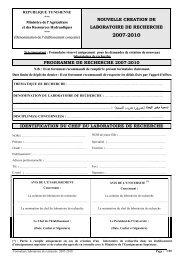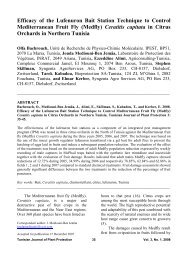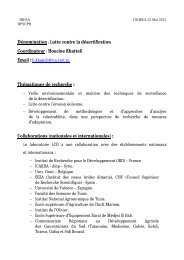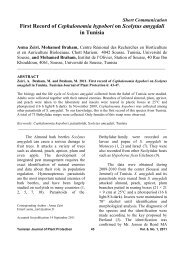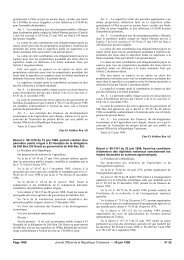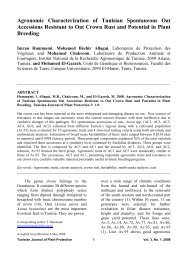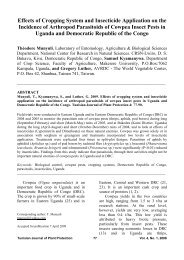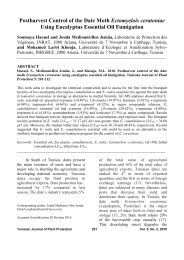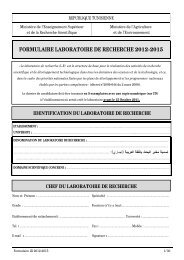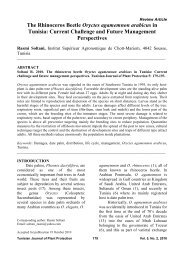Azoxystrobin Activity on Rhizoctonia solani and its Efficacy ... - Iresa
Azoxystrobin Activity on Rhizoctonia solani and its Efficacy ... - Iresa
Azoxystrobin Activity on Rhizoctonia solani and its Efficacy ... - Iresa
Create successful ePaper yourself
Turn your PDF publications into a flip-book with our unique Google optimized e-Paper software.
Short Communicati<strong>on</strong><br />
<str<strong>on</strong>g>Azoxystrobin</str<strong>on</strong>g> <str<strong>on</strong>g>Activity</str<strong>on</strong>g> <strong>on</strong> Rhizoct<strong>on</strong>ia <strong>solani</strong> <strong>and</strong> <strong>its</strong> <strong>Efficacy</strong><br />
Against Rice Sheath Blight<br />
Subramanian Sundravadana <strong>and</strong> Devadas<strong>on</strong> Alice, Department of Plant Pathology,<br />
Sasthan Kuttalam, Department of Agricultural Entomology, <strong>and</strong> Ramasami<br />
Samiyappan, Center for Plant Protecti<strong>on</strong> Studies; Tamil Nadu Agriculture University,<br />
Coimbatore - 641 003, India<br />
_____________________________________________________________________________<br />
ABSTRACT<br />
Sundravadana, S., Alice, D., Kuttalam, S., <strong>and</strong> Samiyappan, R. 2007. <str<strong>on</strong>g>Azoxystrobin</str<strong>on</strong>g> activity <strong>on</strong><br />
Rhizoct<strong>on</strong>ia <strong>solani</strong> <strong>and</strong> <strong>its</strong> efficacy against rice sheath blight. Tunisian Journal of Plant Protecti<strong>on</strong><br />
2: 79-84.<br />
Sheath blight, caused by Rhizoct<strong>on</strong>ia <strong>solani</strong> is <strong>on</strong>e of the major diseases affecting rice crop. We<br />
investigated the effect of azoxystrobin <strong>on</strong> R. <strong>solani</strong> growth (in vitro) <strong>and</strong> <strong>its</strong> efficacy against rice sheath<br />
blight, under field c<strong>on</strong>diti<strong>on</strong>s. The results revealed that azoxystrobin at 1, 2, <strong>and</strong> 4 ppm, completely<br />
inhibited mycelial growth of R. <strong>solani</strong>. Field study showed that foliar spray of azoxystrobin at 125, 250,<br />
<strong>and</strong> 500 g/ha significantly suppressed (> 64%) the development of sheath blight <strong>and</strong> enhanced yield level<br />
(> 60%). For c<strong>on</strong>trolling sheath blight disease, the optimum rate of azoxystrobin was 125 g/ha. Our<br />
results showed also that there was no residue in rice matrices at harvest time <strong>and</strong> no phytotoxicity at the<br />
highest c<strong>on</strong>centrati<strong>on</strong> of azoxystrobin (500 g/ha).<br />
Key words: <str<strong>on</strong>g>Azoxystrobin</str<strong>on</strong>g>, chemical c<strong>on</strong>trol, mycelial growth, residue, Rhizoct<strong>on</strong>ia <strong>solani</strong>, rice, sheath<br />
blight<br />
_____________________________________________________________________________<br />
Sheath blight is the most damaging<br />
disease of rice. It has the potential to<br />
cause severe ec<strong>on</strong>omic loss. Heavily<br />
infected plants produced poorly filled<br />
grains (9). The disease is caused by<br />
Rhizoct<strong>on</strong>ia <strong>solani</strong>. Under favorable<br />
c<strong>on</strong>diti<strong>on</strong>s, infected plants build up a huge<br />
populati<strong>on</strong> of fungal sclerotia in the soil<br />
<strong>and</strong> rice cropping becomes unec<strong>on</strong>omic.<br />
Fungicides are comm<strong>on</strong>ly used in fields<br />
where sheath blight is a limiting<br />
Corresp<strong>on</strong>ding author: S. sundravadana<br />
sundravadana@rediffmail.com<br />
Accepted for publicati<strong>on</strong> 29 November 2007<br />
producti<strong>on</strong> factor. The strobilurin<br />
fungicides were introduced recently<br />
against a broad range of pathogens<br />
(Phytophthora capsici, Alternaria<br />
alternata, Ascochyta rabiei, Puccinia<br />
hemerocallidis <strong>and</strong> Phomopsis sp.) (11, 1, 3,<br />
6, 4). These fungicides reduced disease<br />
development <strong>and</strong> subsequent inoculum<br />
producti<strong>on</strong> <strong>and</strong> increased yield. The<br />
objectives of this study were to evaluate in<br />
vitro activity of azoxystrobin against<br />
mycelial growth of R. <strong>solani</strong>, <strong>its</strong> efficacy<br />
<strong>on</strong> sheath blight incidence under field<br />
c<strong>on</strong>diti<strong>on</strong>s, <strong>and</strong> <strong>its</strong> harvest time residues.<br />
R. <strong>solani</strong> was isolated from infected<br />
rice sheath. Then, the isolate was incubated<br />
<strong>on</strong> potato dextrose agar (PDA) medium at 28<br />
Tunisian Journal of Plant Protecti<strong>on</strong> 79<br />
Vol. 2, No. 2, 2007
± 2°C. The fungicide used in the<br />
experiments is a c<strong>on</strong>centrate suspensi<strong>on</strong> of<br />
<str<strong>on</strong>g>Azoxystrobin</str<strong>on</strong>g> (Amistar).<br />
A 6 mm diameter agar disk from the<br />
margin of an actively growing culture of R.<br />
<strong>solani</strong> was incubated in Petri dishes<br />
c<strong>on</strong>taining PDA amended with<br />
azoxystrobin at c<strong>on</strong>centrati<strong>on</strong>s of 0, 0.25,<br />
0.5, 1, 2, <strong>and</strong> 4 ppm at 28 ± 2°C, 70% RH<br />
for 3 days. Inhibiti<strong>on</strong> of the radial growth<br />
was expressed in percentage, as indicated<br />
in the following fomula: M i = (M c -M t ) / M c<br />
X 100, with M i = Percent of mycelial<br />
growth inhibiti<strong>on</strong>, M c = C<strong>on</strong>trol col<strong>on</strong>y<br />
diameter, <strong>and</strong> M t = Col<strong>on</strong>y diameter in<br />
medium amended with azoxystrobin.<br />
Sclerotia of 7 day-culture of R. <strong>solani</strong> were<br />
dipped in 100 ml beaker, c<strong>on</strong>taining<br />
different c<strong>on</strong>centrati<strong>on</strong>s (0, 0.25, 0.5, 1, 2,<br />
<strong>and</strong> 4 ppm) of azoxystrobin in an aqueous<br />
soluti<strong>on</strong>, then seeded separately at the<br />
center of each Petri plate c<strong>on</strong>taining 2%<br />
agar <strong>and</strong> incubated at 28 ± 2°C, 70% RH.<br />
Radial growth of mycelia was measured 5<br />
days later.<br />
Field experiment was laid out with<br />
rice (ADT43) under r<strong>and</strong>omized block<br />
design, with three replicati<strong>on</strong>s in 5m x 4m<br />
plots. The efficacy of azoxystrobin at six<br />
c<strong>on</strong>centrati<strong>on</strong>s (0, 31.25, 62.50, 125, 250<br />
<strong>and</strong> 500 g/ha) was evaluated <strong>and</strong> compared<br />
to carbendazim (500 g/ha). Three sprays<br />
were applied, since the initial appearance<br />
of sheath blight <strong>and</strong> following a 15 day<br />
interval. Sheath blight incidence was<br />
evaluated with the Relative Lesi<strong>on</strong> Height<br />
(RLH) (8). Therefore, Percent Disease<br />
Index (PDI) was calculated as indicated<br />
below (12). The phytotoxic effect of<br />
azoxystrobin was recorded <strong>on</strong> plants after<br />
each spray in the field trials. The grain yield<br />
was recorded from individual treatment<br />
<strong>and</strong> expressed in per hectare, as indicated<br />
below:<br />
RLH (%) =<br />
Lesi<strong>on</strong> height (cm)<br />
Plant height (cm)<br />
x 100<br />
PDI =<br />
Sum of numerical rating<br />
Total number of plants observed<br />
x<br />
Maximum disease grade<br />
100<br />
At harvest time, azoxystrobin residues<br />
in rice matrices (grain, straw, husk <strong>and</strong><br />
bran) were determined using high<br />
performance liquid chromatography<br />
(HPLC). The rice matrices were extracted<br />
with acet<strong>on</strong>itrile: water (90:10 v/v) <strong>and</strong><br />
partiti<strong>on</strong>ed with an equivalent volume (100<br />
ml) of dichloromethane plus ½ equivalent<br />
volume of 5% NaCl soluti<strong>on</strong> in a<br />
separating funnel for about 1 min. The<br />
sample extract was cleaned up with a<br />
cartridge (Florisil column clean up), the<br />
cartridge was c<strong>on</strong>diti<strong>on</strong>ed with 5 ml of<br />
hexane: dichloromethane (50:50 v/v)<br />
before sample loading (250 ml) <strong>and</strong><br />
washing with 5 ml of dichloromethane <strong>and</strong><br />
ethyl acetate (90:10 v/v). <str<strong>on</strong>g>Azoxystrobin</str<strong>on</strong>g><br />
was eluted from the cartridge using 5 ml of<br />
dichloromethane <strong>and</strong> ethyl acetate (70:30<br />
v/v). The elute was evaporated (<strong>on</strong> a rotary<br />
evaporator at 40°C) to near dryness <strong>and</strong><br />
redissolved the residue in a 10 ml of<br />
acet<strong>on</strong>itrile <strong>and</strong> an aliquot (20 µl) was<br />
injected into the HPLC. <str<strong>on</strong>g>Azoxystrobin</str<strong>on</strong>g> was<br />
separated <strong>on</strong> a Lichro sphere ® 60-RP<br />
column using a mobile phase of<br />
acet<strong>on</strong>itrile: water (80:20 v/v) at a flow<br />
rate of 1 ml/min <strong>and</strong> at a wavelength of<br />
255 ηm. A recovery assay was carried out<br />
using rice matrices plus 0.05, 0.1 or 0.2<br />
ppm of azoxystrobin.<br />
<str<strong>on</strong>g>Azoxystrobin</str<strong>on</strong>g> at three c<strong>on</strong>centrati<strong>on</strong>s<br />
(1, 2 <strong>and</strong> 4 ppm) effectively inhibited in<br />
vitro mycelial growth of R. <strong>solani</strong>.<br />
Tunisian Journal of Plant Protecti<strong>on</strong> 80<br />
Vol. 2, No. 2, 2007
Whereas, at 0.25 <strong>and</strong> 0.5 ppm mycelial<br />
growth inhibiti<strong>on</strong> over c<strong>on</strong>trol ranges from<br />
33 to 39% from mycelia <strong>and</strong> 66 to 81%<br />
from sclerotia (Table 1). Similarly,<br />
azoxystrobin inhibited the spore<br />
germinati<strong>on</strong> <strong>and</strong> mycelial growth of<br />
Alternaria alternata <strong>and</strong> Cladosporium<br />
macrocarpum <strong>on</strong> wheat <strong>and</strong> Ascochyta<br />
rabiei <strong>on</strong> chickpea (1, 3). Strobilurins have<br />
been shown to inhibit the germinati<strong>on</strong> <strong>and</strong><br />
pre-penetrati<strong>on</strong> growth of several plant<br />
pathogenic fungi (10).<br />
Table 1. Effect of azoxystrobin <strong>on</strong> the in vitro mycelial growth of R. <strong>solani</strong><br />
<str<strong>on</strong>g>Azoxystrobin</str<strong>on</strong>g><br />
c<strong>on</strong>centrati<strong>on</strong> (ppm)<br />
From mycelia<br />
(mm)<br />
Mycelial growth<br />
Inhibiti<strong>on</strong><br />
over c<strong>on</strong>trol (%)<br />
From<br />
sclerotia<br />
(mm)<br />
Inhibiti<strong>on</strong><br />
over c<strong>on</strong>trol<br />
(%)<br />
0.25 60.23c 33.08 25.21c 66.00<br />
0.5 54.67b 39.26 13.90b 81.26<br />
1.0 0.00a 100.00 0.00a 100.00<br />
2.0 0.00a 100.00 0.00a 100.00<br />
4.0 0.00a 100.00 0.00a 100.00<br />
C<strong>on</strong>trol 90.00d - 84.20d -<br />
* In a column, means followed by a comm<strong>on</strong> letter are not significantly different at the 5% level by DMRT<br />
Table 2. <strong>Efficacy</strong> of azoxystrobin <strong>on</strong> sheath blight incidence <strong>and</strong> grain yield of rice<br />
Fungicide dose (g/ha)<br />
<str<strong>on</strong>g>Azoxystrobin</str<strong>on</strong>g> 31.25<br />
<str<strong>on</strong>g>Azoxystrobin</str<strong>on</strong>g> 62.5<br />
<str<strong>on</strong>g>Azoxystrobin</str<strong>on</strong>g> 125<br />
<str<strong>on</strong>g>Azoxystrobin</str<strong>on</strong>g> 250<br />
<str<strong>on</strong>g>Azoxystrobin</str<strong>on</strong>g> 500<br />
Carbendazim 500<br />
2.22a<br />
(8.55)<br />
Percent Diseases Index (%)<br />
Time after transplanting (days)<br />
30 45 60 75<br />
2.20a 14.23d 32.81d 42.21d<br />
(7.95) (22.06) (34.85) (40.44)<br />
2.20a 12.36c 29.40c 38.45c<br />
(7.95) (20.46) (32.71) (38.19)<br />
2.20a 7.82a 15.63a 23.53a<br />
(7.95) (15.98) (22.88) (28.51)<br />
2.20a 7.35a 15.36a 23.12a<br />
(7.95) (15.44) (22.66) (28.21)<br />
2.21a 7.35a 15.00a 23.10a<br />
(7.75) (15.44) (22.35) (28.19)<br />
9.23b<br />
(17.48)<br />
25.35b<br />
(30.36)<br />
33.25b<br />
(34.98)<br />
Disease<br />
reducti<strong>on</strong> over<br />
c<strong>on</strong>trol (%)<br />
Yield<br />
(q/ha)<br />
8.84 40.42<br />
19.30 45.92<br />
64.98 62.49<br />
69.23 62.52<br />
69.23 62.58<br />
36.20 55.32<br />
2.20a 21.44e 47.71e 67.40e<br />
C<strong>on</strong>trol<br />
- 33.21<br />
(8.37) (27.53) (43.68) (55.54)<br />
∗ In a column, means followed by a comm<strong>on</strong> letter are not significantly different at the 5% level by<br />
DMRT<br />
* Values in parentheses are arcsine–transformed values<br />
In c<strong>on</strong>trol plots, sheath blight<br />
incidence increased progressively from<br />
PDI 2.20 (30 days) to PDI 67.40 (75 days).<br />
<str<strong>on</strong>g>Azoxystrobin</str<strong>on</strong>g> at 31.25 <strong>and</strong> 62.5 g/ha<br />
slightly suppressed the sheath blight<br />
development, whereas at 125, 250 <strong>and</strong> 500<br />
g/ha, it reduced more than 64% disease<br />
incidence <strong>and</strong> increased more than 60%<br />
rice yield (Table 2). Since there were no<br />
significant differences am<strong>on</strong>g 125, 250 <strong>and</strong><br />
500 g/ha rates in term of decline sheath<br />
blight incidence <strong>and</strong> yield resp<strong>on</strong>se, we<br />
c<strong>on</strong>sider 125 g /ha as the optimum rate for<br />
sheath blight c<strong>on</strong>trol. Besides, all<br />
azoxystrobin c<strong>on</strong>centrati<strong>on</strong>s did not<br />
produce any phytotoxic effect. Therefore,<br />
Tunisian Journal of Plant Protecti<strong>on</strong> 81<br />
Vol. 2, No. 2, 2007
foliar applicati<strong>on</strong> of azoxystrobin<br />
effectively c<strong>on</strong>trol the diseases incidence<br />
like the agents of southern stem rot<br />
(Sclerotium rolfsii), head blight (Fusarium<br />
graminearum), <strong>and</strong> leather rot<br />
(Phytophthora cactorum) (14, 5, 13).<br />
<str<strong>on</strong>g>Azoxystrobin</str<strong>on</strong>g> means recovery from<br />
three fortified (0.05, 0.1 <strong>and</strong> 0.2 ppm) rice<br />
matrices (grain, straw, husk <strong>and</strong> bran) were<br />
86.96%, 84.71% <strong>and</strong> 82.36%, respectively<br />
(Table 3). Therefore, under the specified<br />
c<strong>on</strong>diti<strong>on</strong>s no interfering peaks were<br />
observed <strong>on</strong> the chromatogram of the<br />
samples. The instrument did not detect<br />
residues of azoxystrobin even at the<br />
highest applied c<strong>on</strong>centrati<strong>on</strong>. Then, we<br />
can suppose that the residues of<br />
azoxystrobin in rice matrices were below<br />
the limit of detecti<strong>on</strong> of the instrument<br />
(0.004 µg/g of sample). C<strong>on</strong>sidering the<br />
U.S. Envir<strong>on</strong>mental Protecti<strong>on</strong> Agency<br />
(EPA), the maximum residue lim<strong>its</strong><br />
(MRLs) for azoxystrobin in rice grain,<br />
straw <strong>and</strong> hulls are, respectively 5, 12 <strong>and</strong><br />
20 ppm (7). Therefore, it seems that<br />
azoxystrobin in our trials was rapidly<br />
metabolized in rice plants. Chen et al. (2)<br />
obtained a similar result in Chinese<br />
cabbage. Hence, foliar applicati<strong>on</strong> of<br />
azoxystrobin to c<strong>on</strong>trol sheath blight is<br />
very unlikely to cause acute <strong>and</strong> chr<strong>on</strong>ic<br />
health risk.<br />
Table 3. Recovery percentage of azoxystrobin in fortified rice samples<br />
Rice matrice<br />
<str<strong>on</strong>g>Azoxystrobin</str<strong>on</strong>g> recovery (%)<br />
0.05 ppm 0.1 ppm 0.2 ppm<br />
Mean<br />
recovery<br />
(%)<br />
Recovery<br />
factor<br />
(RF)<br />
Grains 80.12 82.86 97.91 86.96 1.15<br />
Straw 85.12 81.32 87.69 84.71 1.18<br />
Bran & Husk 80.00 84.90 82.18 82.36 1.21<br />
* Determinability of the instrument = 0.004 µg/g of sample.<br />
____________________________________________________________________________<br />
RESUME<br />
Sundravadana S., Alice D., Kuttalam S., et Samiyappan R. 2007. Activité de l’azoxystrobine sur<br />
Rhizoct<strong>on</strong>ia <strong>solani</strong> et s<strong>on</strong> efficacité c<strong>on</strong>tre la brûlure de la gaine foliaire du riz. Tunisian Journal of<br />
Plant Protecti<strong>on</strong> 2: 79-84.<br />
La brûlure de la gaine foliaire, causée par Rhizoct<strong>on</strong>ia <strong>solani</strong>, est l’une des principales maladies du riz.<br />
Nous av<strong>on</strong>s étudié l’effet de l’azoxystrobine sur la croissance in vitro de R. <strong>solani</strong> et s<strong>on</strong> efficacité c<strong>on</strong>tre<br />
cette maladie en plein champ. Les résultats <strong>on</strong>t révélé que l’azoxystrobine à 1, 2 et 4 ppm, inhibe<br />
complètement la croissance mycélienne de R. <strong>solani</strong>. L’étude au champ a m<strong>on</strong>tré que la pulvérisati<strong>on</strong><br />
foliaire de l’azoxystrobine à 125, 250 et 500 g/ha supprime significativement (> 64%) le développement<br />
de la brûlure de la gaine foliaire et augmente le rendement (> 60%). Pour c<strong>on</strong>trôler cette maladie, la dose<br />
optimale d’azoxystrobine était de 125 g/ha. Nos résultats <strong>on</strong>t indiqué aussi qu’il n’y avait pas de résidus<br />
dans les plantes du riz au moment de la récolte et pas de phytotoxicité avec la plus haute c<strong>on</strong>centrati<strong>on</strong><br />
d’azoxystrobine (500 g/ha).<br />
Mots clés : <str<strong>on</strong>g>Azoxystrobin</str<strong>on</strong>g>e, brûlure de la gaine foliaire, croissance mycélienne, lutte chimique, résidus,<br />
Rhizoct<strong>on</strong>ia <strong>solani</strong>, riz<br />
_____________________________________________________________________________<br />
Tunisian Journal of Plant Protecti<strong>on</strong> 82<br />
Vol. 2, No. 2, 2007
____________________________________________________________________________<br />
.2007<br />
ملخص<br />
صندرافادانا، سوبرامانيان ودافاداصون أليس وساسثان كوتالام وراماسامي سامييابان.<br />
على الفطر Rhizoct<strong>on</strong>ia <strong>solani</strong> ونجاعته ضد لفحة الغمد الورقي للأرز.<br />
تأثير الأزوكسيستروبين<br />
Tunisian Journal of Plant Protecti<strong>on</strong><br />
2: 79-84.<br />
تع د لفحة الغمد الورقي التي يحدثها الفطر Rhizoct<strong>on</strong>ia <strong>solani</strong> من أهم الأمراض التي تصيب الأرز. تمت دراسة تأثير<br />
R. <strong>solani</strong><br />
الأزوكسيستروبين<br />
في<br />
الأزوكسيستروبين بتراكيز<br />
نمو الفطر<br />
في البلور<br />
ونجاعته ضد هذا المرض في الحقل.<br />
أظهرت النتائج أن<br />
جزء بالمليون يثبط كليا النمو الغزلي للفطر. وبينت الدراسة في الحقل أن الرش<br />
125 و 250 و<br />
1 و 2 و 4<br />
الورقي بالأزوكسيستروبين بالجرعات<br />
الإنتاجية وتزيد<br />
500 غ/هك تحد معنويا<br />
كانت الجرعة المثلى لمكافحة هذا المرض<br />
(>64%) من تطور لفحة الغمد الورقي<br />
أظهرت نتائجنا كذلك<br />
عدم وجود<br />
125 غ/هك.<br />
.(60%
13. Rebollar-Alviter, A., Madden, L. V., Ellis, M.A.,<br />
2005. <strong>Efficacy</strong> of azoxystrobin, pyraclostrobin,<br />
potassium phosphite <strong>and</strong> mefenoxam for c<strong>on</strong>trol<br />
of strawberry leather rot caused by Phytophthora<br />
cactorum. Online. Plant Health Progress<br />
[doi:10.1094/PHP-2005-0107-01-RS]<br />
14. Rideout, S. L., Brenneman, T. B., <strong>and</strong> Culbreath,<br />
A. K. 2002. Peanut disease management utilizing<br />
an in-furrow treatment of azoxystrobin. Plant<br />
Health Progress [DOI: 10.1094/PHP-2002-0916-<br />
01-RS].<br />
----------------------<br />
Tunisian Journal of Plant Protecti<strong>on</strong> 84<br />
Vol. 2, No. 2, 2007




